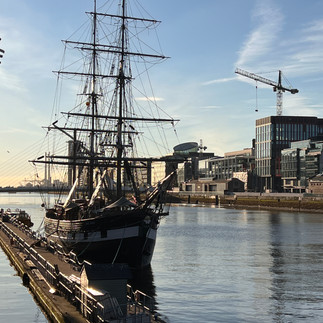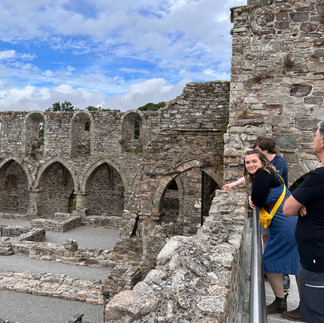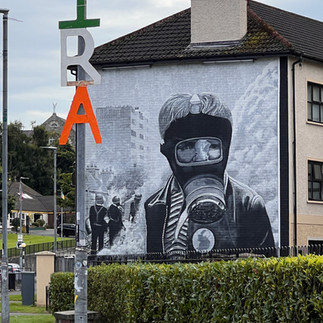
Ireland is an incredibly beautiful country that will capture your heart. From the friendly Irish folk to the colorful charming villages, to ancient castles and abbeys, to the incredible natural landscapes, Ireland can offer amazing experiences. We were fortunate to travel there this August, with Covid mostly in the rear-view mirror and our family of five plus dear friends, Alex and Fiona, from Scotland in tow. Both sides of Kevin’s family hale from Ireland and with kids named Declan and Cormac, we knew this will be a special trip.
We planned for a 13-day trip, but thanks to a canceled flight (common these days), we ended up with a 12-day trip. This was not a great way to start our journey, bags packed and ready to go to the airport getting an email about a 3-hour delay that later turned into a 24-hour delay, and rebooking on an entirely different airline. But we were thankful the rebooked flight went as planned and we arrived at Dublin International airport only a day late.
Our overall itinerary:
Day 1: Travel day, leave in the evening.
Day 2: Arrive in Dublin mid-morning and drive to Kilkenny, Kilkenny Castle and explore town
Day 3: Explore historic sites around Kilkenny (Jerpoint Abbey, Kells Priory, Knockroe Tombs/Stone Circle) and evening in Kilkenny
Day 4: Rock of Cashel, Ennis lunch, Cliffs of Moher, The Burren, stay in Connemara
Day 5: Connemara famine day, Doolough Valley, Westport, Cong Abbey, and hike
Day 6: Connemara National Park, Diamond Hill hike, Kylemore Abbey (viewpoint only), Clifden Castle, Clifden
Day 7: Carrowmore Megalithic Cemetery, Donegal Town, Donegal Castle, stay in Magheraroarty in County Donegal
Day 8: Horn Head hike, Aileach Ring Fort, Derry
Day 9: Glenveagh National Park, Magheraroarty Beach
Day 10: Drive to Dublin, explore the city
Day 11: Kilmanheim Gaol, EPIC Museum, Guinness Storehouse
Day 12: Fly out of Dublin airport in the morning
Without travel days, the pace was 3 (turned out to be 2), 3, 3, 2. We didn’t want to stay for less than 2 nights in any one place, so we weren’t constantly packing up. This pace was good. We stayed in cottages in the country (through Airbnb) near Kilkenny, Oughterard (Connemara), Magheraroarty (northern Co Donegal), and then a hostel in Dublin.
This map shows our rough route, without all the side trips from our bases.

A Relatively Small Island
You might be surprised to know that the state of Minnesota is 2.9 x larger than the entire island of Ireland! This fact might tempt a person to think they can see it all on a 10-14 day trip, but the reality is that the island FEELS a whole lot bigger in person because it takes longer than expected to drive anywhere. The narrow twisting and winding roads slow down the drive, which is important to remember when planning a trip. It’s important to slow down, limit your “must-see” sights, and relax and breathe in the Irish air.

Is there anything we’d change?
That depends on who you ask! Kevin wishes we would have skipped the Cliffs of Moher and spent time in Galway. He also missed staying in towns where we might have more chances to interact with locals and attend trad sessions in the pubs in the evenings. I wish we had seen Slieve League (cliffs near Donegal). The kids could have skipped Dublin altogether, but Kevin loves it. Fiona and Alex likely wish we would have done a larger portion of the driving.
Overall, I think we had a pretty good itinerary, a good balance, and some amazing days of sightseeing without it feeling too rushed or hectic.
Kevin explains how to drink a proper pint of Guinness
The Magic of Pub Lunches
When I am on vacation, I love having a beer with lunch. And no place in the world is this more treasured than in Ireland, where a Guinness for lunch is pretty much required. You may be surprised to know that Guinness has pretty low alcohol content at 4.2% - which is exactly what a Miller Lite, Coors Light, or Bud Light clocks in at. With the rich taste and foamy creamy top of a Guinness, it is filling, and makes for the perfect vacation lunch beer!
That, together with the famous Irish pub lunches, was the constant in most of our days. Our favorites were Guinness stew, fish and chips, and chips (chips with pretty much everything), and chicken wings (Declan’s quest was to have wings every day and I think he succeeded). The food was pretty good—not amazing cuisine, but solidly good food.
Below are the highlights of the trip. More detail to come in future blogs on each region we visited.

Kilkenny
Kilkenny is a quintessential Irish village with colorful storefronts marching along the winding narrow streets, blooming flowerpots adorning the streets and riverfront, cathedrals and church spires standing watch, and a lovely castle within the historic town center. There are no Mcdonald's, Gap, or Nike stores - just family-owned businesses and well-loved pubs.
Kilkenny Castle was the first OPW (Office of Public Works) heritage site we visited and we decided to purchase the OPW card which would get us entrance into all heritage sites for a year. The castle tour provided good information and was worth the extra time when touring the castle. Make sure to spend some time both in the rose garden and in the open courtyard on the other side of the castle.
Daytrips from Kilkenny
We visited some wonderful heritage sites around Kilkenny. Jerpoint Abbey (super interesting guided tour), Kells Priory (beautiful setting in the country and loop walk), and Knockroe Tomb/Stone Circle (also beautiful setting) Visiting these three sites and spending the evening listening to some Irish music over dinner in a Kilkenny pub is about the most perfect day ever.

Rock of Cashel
We arrived early at this busy tourist spot and were glad we did. This cluster of medieval buildings perched on top of a dramatic limestone outcropping is impressive. We got a guided tour of Cormac’s Chapel while overlooking St. Declan’s Way. To have Cormac and Declan’s names both represented in this place was special.

Ennis
Driving between Kilkenny and the Cliffs of Moher, we stopped in Ennis, County Clare for a pub lunch and walked around a wee bit. This was a lovely, tight-knit town on the banks of River Fergus - it has been voted 'friendliest town" in Ireland many years running.

Cliffs of Moher
One of the most visited sites in Ireland, it is impressive but also very crowded and feels a bit too touristy (as compared to what it was like 25 years ago). The weather here is highly volatile. When we drove into the parking, it was raining so we went into the visitor center. After 10 minutes it was done raining and the sun was coming out. We walked to the cliff edge and by the time we walked to one of the far edges, a new raincloud was upon us. And the WIND! The wind is also fierce in this place.

The Burren
We stopped and walked around the Poulnabrone Dolmen. The strange rocky landscape deserves some time to slow down and investigate. You must watch your footing and step on the rocks, as a misstep into the mossy boggy areas in between the rocks could be a real ankle breaker. I loved the variety of colorful wildflowers staking their claim in this lunar environment.
Connemara
We spent several days exploring Connemara. Our Airbnb was right outside Oughterard and we drove over the Quiet Man bridge to get to our cottage. The Quiet Man bridge is from the 1952 John Wayne/Maureen O’Hara movie that was filmed in this area. There is a statue of the famous couple in Cong and a museum dedicated to the movie as well.
Other highlights include Killary Fjord, Connemara Woolen Center, Aasleagh Falls, Doolough Valley, Westport, and Cong Abbey and hike.
Connemara National Park and Clifden
We took a strenuous hike up the steep Diamond Hill (7.6 km hike up a 1450 ft “hill”) for a beautiful view over the countryside and Kylemore Abbey. A part of the Wild Atlantic Way covering most of the West coast of Ireland, we drove Sky Road, which featured really amazing views overlooking the Atlantic with carpets of wildflowers as a backdrop. Outside of Clifden, we walked to Clifden Castle, which brings you through a working farm, where we were lucky to see a sheepdog and sheep herd in action.

Carrowmore Megalithic Cemetery
Carrowmore is the oldest and densest concentration of Neolithic tombs in Ireland. Located near Sligo town, this heritage site has a view of Queen Maeve’s Cairn on Knocknarea, as well as the remains of over 35 passage tombs. We recommend the guided tour to get the real story about these stone circles. Our tour guide was a working archaeologist and brought incredible insight and information to the tour.

Donegal
Donegal Town proved to be quite busy on the day we visited. It was a market Saturday, after all. We visited Donegal Castle and then struggled to find an open seat for a late lunch. This bustling city deserved a bit more time than we had and would be a good place to use as a base to explore the area. Just to the west of Donegal town is the Slieve League. This area offers sea cliffs that are grander than those at the Cliffs of Moher and far less touristy, but as it's a bit off the beaten path, takes a bit longer to get there, and unfortunately, we just didn’t have time to see them.
County Donegal & Derry
From our base in Magheraroarty in Northern Donegal County, we were able to explore a number of non-touristy places. We loved walking on the gorgeous sandy beach, drove to Horn Head for a hike over the dramatic cliffs (in some ways better than Cliffs of Moher because there were far fewer people and it was wilder), Aileach Ring Fort, and then a stop in Derry in Northern Ireland. We are big fans of Derry Girls (show on Netflix), so a stop in Derry was fun - but also sobering as we viewed the Bogside Murals in "Free Derry" illustrating the sectarian violence that occurred during the Troubles.

Glen Veagh National Park
Our group split in two, so the boys (Kevin, Declan, and Cormac) could conquer Mount Errigal (a 6 km hike up this 2463 ft high mountain), while the rest of us walked along the lake to Glenveagh Castle and back. The castle is surrounded by lovely formal gardens.
Dublin
After 8 days of charming villages, ancient ruins, and breathtaking views, Dublin can feel a little too much like any European city. Yes, it is charming in its own way, but busy, bustling, and full of tourists. We did manage to squeeze in a number of pub visits (Jacob’s Inn, Mulligans, Toners, Ryans, Brazen Head, and Neary’s). We also did some of the usual touristy things: EPIC immigration museum (great exhibits), Kilmainham Gaol, Guinness Storehouse (overhyped), and Dublin Castle (boring to us). Part of the fun of Dublin (or any town for that matter) is just walking around and exploring the neighborhoods. If we'd had more time here we would have visited a few more museums, neighborhood haunts, and pubs! Next time.
After 12 days in this magical country with dear friends and family, we departed full of new lifelong memories of this wonderful trip.!

What to expect for weather in August
My thought is that you should expect rain every damn day and then feel blessed to not have that happen! August is Ireland’s warmest month and prior to our arrival, they were having a record-breaking heat wave with temperatures up to 90 degrees. That streak had passed by the time we arrived toward the end of August and the weather was back to normal with lows in the low 50s and highs in the mid-70s with most days being somewhere in between. If the sun was out, it felt warm regardless of the temperature. When the sun was hidden by clouds, it felt cool, unless we were hiking, then it felt warm. The concept of wearing layers is the key.
What to pack
Rule #1: pack less than what you think you need. You really don’t need to wear fresh shirts or pants every day and you can wash your undies and socks in the sink at night.
Waterproof shoes or pants are not needed unless you are planning long hikes in the pouring rain. The key is to have wool socks, which keep your feet from feeling wet and still have insulating properties while wet and dry quickly. I didn’t bring jeans because of their weight and the fact that they don’t dry quickly. Think quick dry, lightweight, and layers.
A very light raincoat with a hood is sufficient. I debated over my fully waterproof (and heavier) raincoat, versus a water-resistant, lightweight coat. In the end, I was very glad I took the lightweight coat. I sprayed it with Nixwax to make it as waterproof as possible and it worked. Leave the umbrella at home and make sure you have a hood on the raincoat.

Drive or Train/Bus?
We planned for a driving trip, despite the fact we hate to drive cars on holiday in Europe. We were a group of 7 people that wanted to focus on the countryside and sites outside of the major cities. Thus, a minivan with automatic transmission was the plan. This plan will only work if you pack light and with soft-sided backpacks or bags, which we did. It was a tight fit and if everyone had roller bags, it wouldn’t have worked.
Our daughter Mazzy had just traveled to Ireland in 2021 and used only mass transportation. That worked for her and could very well work for many people who want to focus on areas connected by easy transit.
Beware, vehicle rental is very expensive in Ireland. At nearly $3,000 for the mini-van, this was the most costly part of our trip. We originally rented through AutoEurope, but when I went to get a collision damage waiver certificate from my US Bank Visa card, I realized they had quietly dropped this benefit at some point. Thus, we were going to have to purchase the extra insurance through Sixt, which was the car rental counter that AutoEurope was booking us through. I was concerned about being beholden to whatever price Sixt wanted to charge us and potentially still not having tire or glass coverage. With some extra research, I found that My Irish Cousin rentals were all-inclusive and highly recommended. I was able to cancel the AutoEurope rental without penalty and make a new reservation through My Irish Cousin.
This ended up being a huge benefit to us, as their rentals include a free second driver and with the personalized service they offer, Cousin Malachy was able to allow Alex to pick up the rental car when our flight was delayed for a day. Drop-off was easy, as insurance covers any damage that we might have incurred (Alex was a most excellent driver and we didn’t have any damage anyway). We were also able to drop off the vehicle in Dublin city center for our last 2 days in Dublin, which was a big time and money-saver for us. Having a car within Dublin is something to avoid, as it is expensive to park and is generally not needed as Dublin is very walkable.
What to budget per day for Ireland
We aren’t fancy travelers. We like a good meal once in a while and like to have our lodging contribute to good sleep. And yes, we sometimes stay in hostels when hotels are too expensive (Dublin!). For our group of 7, we spent about $100/ person/ day for everything except airfare. Car rental and gasoline were the most expensive part of this trip for us.
How does $100/day compare to Italy? Interestingly, we spent about the same amount per person per day for our Italy trip in the spring - but our lodging and meals were much better in Italy (better Airbnbs and restaurant dinners). Of course, if you are staying in a castle and eating at high-end restaurants every night, or doing guided tours, the $100/day can quickly double.
Air Fare
When buying 5 plane tickets, we want to get the best deal possible. Although we are Delta frequent fliers, we couldn’t pass up the $475 tickets for MSP to DUB with Iceland Air. The pit stop in Reykjavik was scheduled to be short. We bought the tickets about 6 months out from the trip.
The unfortunate part was that they canceled our outgoing flight. Because of the limited flights, they couldn’t get us on a flight until the next day and they rebooked us on Delta - which ended up being fine because we were seated in comfort class. Our return flight on Iceland Air through Reykjavik was as planned and we enjoyed picking up some souvenirs in the airport during the wait.
Our best tip for getting good airfare is to set a Google Flight alert.
And consider flying into Dublin and out of Shannon if you have limited time and want to spend more of it on the west coast.
Cell Service vs WiFi Hotspot
Based on recommendations from Ireland - Tips for Travellers Facebook page, we opted for the WiFi Candy hotspot device. You order ahead of time and pick it up at the luggage counter at the Dublin Airport. It says you can connect up to 10 users and the 2-week plan cost $160 euros. We found this option to be a hassle and disappointing. It was another device we needed to keep charged (the charge didn't last all day) and it didn't always work. In the future, we will use the Verizon international $10/day plan - though if everyone in our family would have had just used the Verizon plan it would have been a cost of $50/ per day. The wi-fi candy option was far less expensive.
The Ireland Facebook page linked above is helpful, but also has some crazy collective advice (in my opinion) - such as bringing a top sheet because duvet covers are used in lieu of flat sheets, bringing washcloths because they aren't common in Ireland, and pack waterproof gear head to toe - and then they wonder how to fit all these unnecessary stuff into a carry-on. If one wants all the comforts and everything to be like home, one should stay at home in our opinion. Still, it's a good site to follow prior to a trip to get up to speed on the current situation and it's a better resource for questions than TripAdvisor is for Ireland.




























































































Comments